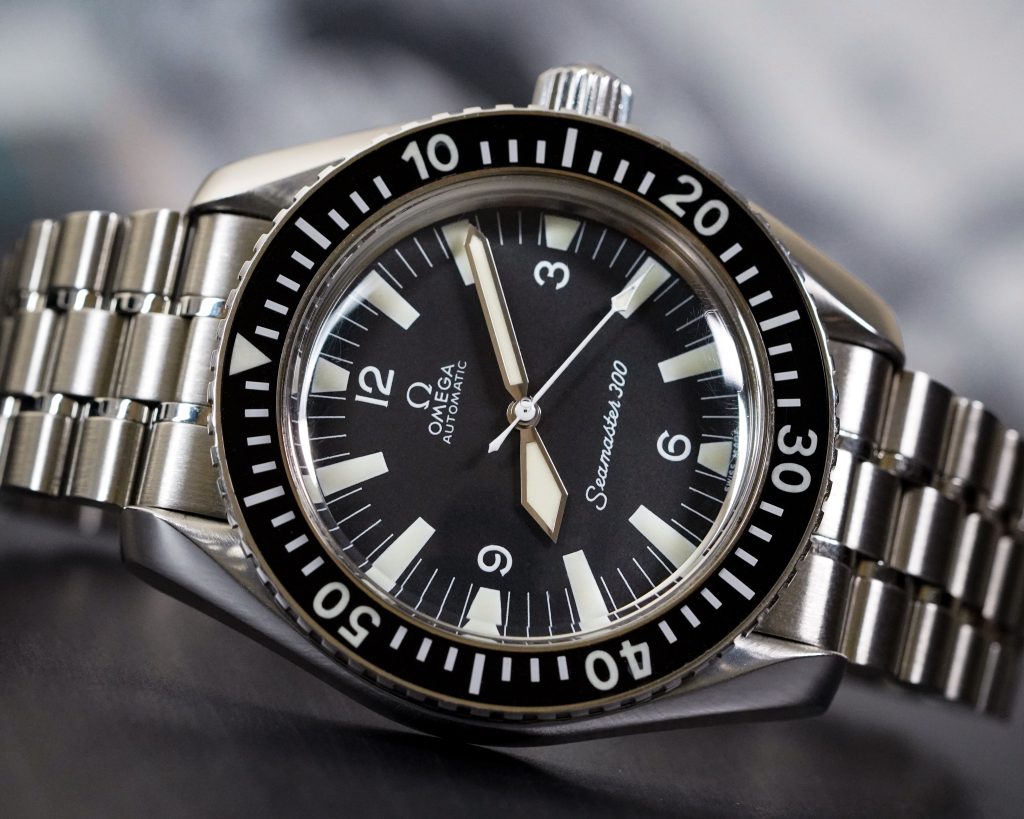Beans & Bezels Beans & Bezels B&B
Disclaimer: this video/review was not sponsored by MKII Watches or any other entity.
Video
Review
The military-issue dive watch sub-genre has always fascinated me, and the era of the MilSpec divers, featuring legendary pieces like the Omega Seamaster 300, Rolex MilSub, and CWC Royal Navy 300 stands out as my favorite. Some of my earliest microbrand purchases were watches that emulated the Seamaster 300 aesthetic, and I came across the MKII Project 300 numerous times, but I eventually managed to hunt down and purchase a WatchCo 165.024 Seamaster 300, which remains one of my most cherished pieces. I also picked up a CWC Royal Navy 300, custom-engraved with my Beans & Bezels logo, leaving the Rolex MilSub as the only missing piece in my ideal trio.

Naturally, when MKII relaunched the Fulcrum in a new 39mm size, I was excited to see if it could fill that gap in my collection. While MKII has produced more faithful MilSub homages in the past, such as the LRRP MilSub, the Fulcrum is also a tribute to that genre, albeit with a more modernized design twist. Bill Yao, the man behind MKII and Tornek Rayville, has an excellent eye for detail and has built a brand ethos that truly respects and understands military watch heritage. His Seamaster 300 homage remains one of the best alternatives to an actual vintage Seamaster 300 or a WatchCo build, so my expectations for the Fulcrum 39 were high.

The watch launched at a retail price of $995, and after taxes, I paid just under $1,025 for this no-date dive bezel version. Given Yao’s nearly two decades in the microbrand space and his expertise in military watch design, I had hoped this watch might scratch my Rolex MilSub itch; but after spending time with it, I’m not entirely convinced it does.
Let’s get into why…
Case
The case of the Fulcrum measures 39.15mm in diameter, 46.15mm from lug to lug, 39.5mm across the bezel, and 14.10mm thick; made entirely of stainless steel with a uniform bead-blasted finish. The design attempts to blend old Rolex case elements with modern Tudor proportions, but unfortunately, that’s not much of a compliment. The result is a watch that looks and feels disproportionately thick, with only slight relief provided by two bevels along the top of the case, which do little to offset the visual bulk of its 7mm thick mid-case. The drilled through 20mm lugs are definitely a nice to have, and are a welcomed nod towards old dive watch design.

I do appreciate the bezel design as it captures the feel of an old Rolex Submariner well, and the aluminum bezel insert is complemented by excellent action, ranking among the best you’ll find in this price range. However, the choice of a curved double-domed sapphire crystal feels somewhat awkward. A boxed sapphire would have been a far better aesthetic and functional fit, staying truer to the MilSub inspiration.

The MKII website states that this decision was made intentionally for increased durability and lower cost of maintenance compared to a boxed crystal, but I’m not convinced. While the underside anti-reflective coating is present, it does little to combat glare, making daytime legibility frustratingly poor – though I suspect underwater readability would fare better due to the double-domed structure.

The 6.35mm screw-down crown at 3 o’clock is well-executed, easy to grip, and embossed with the MKII logo, while the screw-down case back remains plain with some basic engravings, ensuring a solid 200m water resistance.

Overall, while the build quality of the case is commendable, the design choices leave me wanting something closer to the proportions and execution of a true MilSub. The excessive thickness and crystal choice make it feel clumsier than it should be, which is a bit disappointing given MKII’s usual attention to detail.
Dial
The dial of the MKII Fulcrum 39 is, at its core, one of the strongest aspects of the watch. It stays true to the mil-spec diver aesthetic with excellent legibility, bold sword hands, and the iconic big triangle at 12 o’clock, all wrapped in a simple, high-contrast design that feels both purposeful and refined. Rather than leaning purely into Rolex-style cues, MKII opted for a hybrid approach, borrowing more from Omega and CWC’s versions of this genre, and the result is a dial that looks both familiar and uniquely its own.

The wide outer track, printed in white, features bold five-minute markers and finer ticks for the rest, and the printing itself is crisp and precise. The big printed triangle at 12 o’clock is complemented by large rectangular indices at the cardinal points and smaller rectangles for the remaining hours, all of which are generously lumed.

Despite being a printed dial, the sheer amount of lume applied gives the indices a subtle dimensionality, showing that MKII didn’t skimp on materials here. My favorite element of any mil-spec diver is the use of broad sword hands, and this watch delivers them in great proportions with ample lume for nighttime visibility.

Ultimately, it was the dial design that pushed me to buy this watch – it is undeniably attractive, and even more so to someone like me who loves this genre of dive watches. However, I have to say that the quality control is a bit disappointing. Under even minor magnification, I’ve noticed stray paint particles on the dial and a seconds hand that looks noticeably dirty, which takes away from an otherwise well-executed design.
Lume
Despite having a printed dial rather than applied indices or Lumicast/Globolight style blocks, the Fulcrum 39 delivers an impressive amount of lume that exceeds expectations. Both the dial and hands glow intensely and maintain their brightness for an extended period, ensuring excellent nighttime legibility. The only weak point is the lumed pip on the bezel, which fades much quicker than the rest of the watch.

In direct comparison with my CWC RN300, Christopher Ward Lumiere, and titanium Rolex Yachtmaster, the Fulcrum 39 easily outshines the similarly priced RN300 and holds its own against the more premium Lumiere and Yachtmaster. For those who are particular about lume and hesitant about the printed dial, this watch should put any concerns to rest. It is likely as legible in the dark as many applied-indices dials with strong lume.

Movement
The Fulcrum is powered by the Miyota 90S5, a movement I regard as one of the better affordable options in terms of reliability and durability. While its unidirectional winding rotor is a bit noisy, that’s a minor trade-off for avoiding the Sellita SW200 and ETA 2824, both of which I actively steer clear of after years of frustrating experiences across numerous watches. One detail I really appreciate is that MKII opted for the no-date version of the movement in watches without a date window – a thoughtful choice that avoids the annoyance of a phantom date position, especially at this price point.

That said, for a watch housing one of the slimmest movements in this price range, the Fulcrum does feel needlessly thick, especially considering that this same movement is found in watches that are 25–30% thinner. In terms of performance, though, I have no complaints. The watch has been running at a solid +6 seconds per day, and MKII includes a quality control card that goes to show that they took the time to regulate it properly.
On The Wrist
On the wrist, the Fulcrum wears more like a 40mm watch, which works well for my 6.75” wrist. This is largely due to its 39.5mm bezel and generally stout design, giving it a bit more presence than the diameter alone would suggest. The 46.15mm lug-to-lug distance makes for a compact and comfortable fit, but the 14.10mm thickness, paired with its slab-sided case, does make it feel tall, much like the early in-house movement Tudor Black Bays. The domed crystal further amplifies this impression, making the watch appear even chunkier than it already is.


The bracelet is a mixed bag. While the end link fitment is excellent and integrates seamlessly with the case, the rest of the bracelet feels fairly mediocre. The links are simple, squared-off, and a bit sharper around the edges than I’d prefer, lacking any standout finishing or contouring. The clasp, made by Nodus, is their NodeX design, which I appreciate for its push-button adjustability, but the connection between the clasp and the links feels somewhat janky and doesn’t inspire a ton of confidence.


At $1,000, considering the competition from brands like Christopher Ward and Zelos, I think the bracelet is the weakest part of the package. The NodeX clasp is a notable step up from what I saw on the Tornek Rayville I reviewed previously, but there’s definitely room for refinement in the overall fit and feel.
Wrapping Up
If I sound like I’m not sold on the MKII Fulcrum 39, it’s because I’m not. I have a deep appreciation for the MilSpec genre and have owned or handled nearly every homage out there, as well as true pedigree pieces like the Omega Seamaster 300 165.024 and the CWC Royal Navy 300. I’ve also spent time with MKII’s Project 300, which I found to be a genuinely impressive watch. But with the Fulcrum 39, I can’t shake the feeling of being underwhelmed.
Bill Yao is exceptional at curating a military-inspired aesthetic, both in his branding and how he positions his watches in the market. He arguably understands the heritage of these pieces, and the genre in general, better than any other brand making homage-style watches today. And yet, something about the Fulcrum feels off. It doesn’t have the sense of refinement or thoughtful execution I expect from MKII; instead, it feels like a watch any no-name Chinese factory could have churned out, rather than one crafted by someone with such deep respect for the genre. Maybe I’m being too harsh, but in 2025, the standard for build quality and finishing continues to rise, and $1,000 gets you a lot of watch these days. This just doesn’t feel like the best option at that price. And I say that as someone who owns the CWC RN300, a watch that is arguably overpriced itself – but at least it captures some of the essence of what made the original MilSpec divers so special.

